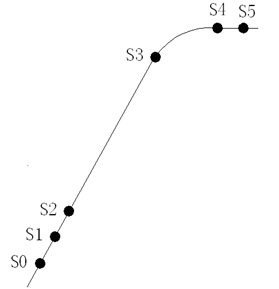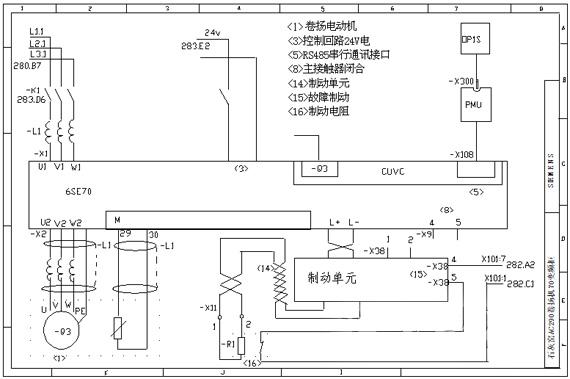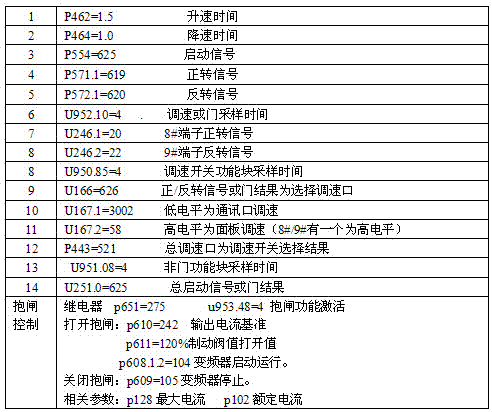1 Overview
The process of Laigang Maerz lime kiln is introduced from Switzerland, and the whole production process is automatically controlled. The feeding system adopts inclined bridge type material car feeding, which is mainly composed of three parts: inclined bridge, material car and winch motor. The movement of the material car on the inclined bridge is divided into six stages: starting, acceleration, stable operation, deceleration, tipping and braking.
2 Control system solution
2.1 Main electrical equipment of feeding and kiln bottom system
1. The AC motor power of the hoisting mechanism is 55kW, three-phase AC 380V, one set;
2. The brake of the material car is 1kW, two sets of two-phase AC 380V;
3. One AC frequency conversion transmission cabinet and one brake resistor cabinet;
4. The frequency converter of the material car is Siemens 6SE70 75kW, with a matching brake unit;
5. Position detection proximity switch;
6. PLC system.
2.2 Basic process requirements
1. Material car winch: The material car winch runs according to the material car travel curve;
2. In the manual mode of PLC and on-site operating console (only for maintenance), it meets the high and low speed regulation requirements;
3. The starting, stopping, acceleration and deceleration of the material car should be smooth, and the speed control is less affected by the load (no load or full load);
4. The main winch has wire rope slack protection and ultimate tension protection device (overcurrent protection);
5. The material car has upper and lower travel limit protection devices;
6. The drum reversal protection when the material car has not reached the end of the travel; in the state of a truck, it is allowed to stop or control the descent.
2.3 Design
The system block diagram is shown in Figure 1.

Figure 1 System Block Diagram
2.3.1 Winch frequency conversion speed regulation device
We use Siemens' 6SE70 fully digital AC frequency conversion speed control device. The system is equipped with a matching brake unit and an independent brake resistor cabinet, and uses energy consumption braking to achieve the braking of the winch system. The control signal of the frequency converter is completed through the electrical equipment of the frequency converter cabinet to complete the basic interlocking and control. The PLC and the frequency converter cabinet, and the on-site operating console and the frequency converter cabinet are isolated from each other by relays, so that the control of the material car can be controlled by the PLC or the on-site operating console respectively, improving the reliability of the entire system. The brake is controlled by the brake-specific control function in the 6SE70 device to achieve brake control and interlocking control during the operation of the material car.
2.3.2 Cart Positioning
The positioning of the material cart is completed by the on-site proximity switch, which is sent to the frequency converter cabinet and PLC in the form of switch quantity; the acceleration, deceleration and parking positions are sent to the PLC, and the PLC controls the frequency converter. The limit position is sent to the frequency converter cabinet for power-off protection and to the PLC for fault analysis.
2.3.3 Introduction to material car operation
The material cart is at the bottom of the pit. After the materials are loaded, the pit gate is closed, the hopper on the top of the kiln is empty, and the material is applied. The PLC sends a command to the inverter. After receiving the start command, the 6SE70 system is unblocked. Through the brake control function in the 6SE70 system, after the starting torque current given by the torque limit in the brake state is established, the 6SE70 system issues an open brake command to open the brake and realize the smooth start of the material cart.
When the material car starts running, the required running torque current is greater than the starting torque current, and the originally established torque limit will return to the normal limit value. After starting, the material car will start to ascend from s1 at a speed of 10HZ; when the position switch detects the acceleration point s2, the PLC sends a command to the inverter, and the running speed increases to 45HZ; when it ascends to the deceleration position s3 (close to the kiln top bend), the running speed is reduced to 10HZ; when the material car runs to the kiln top tipping position s4, the PLC sends a stop command to control 6SE70 to complete the parking, and the brake is closed. At this time, the parking position of the material car should be the angle required by the process, that is, the furnace charge in the car can be emptied without sensing the limit position, completing the upward unloading process. See the material car travel curve diagram 2, the control principle of the downward process is the same as the upward process.

Figure 2 Material car travel curve
In Figure 2,
s0: Downward limit position
s1: Upward starting position (downward parking position)
s2: Upward acceleration position (downward deceleration position)
s3: Upward deceleration position (downward acceleration position)
s4: Upward parking position (downward starting position)
s5: Upward limit position
3 Inverter interface diagram:

4. Main control parameter settings of the inverter

5 Application Effects
The winch control system is the basis for realizing the automatic control of the entire production process of Maerz kiln. By adopting advanced Siemens inverter and stable PLC control technology, the accuracy and stability of the most important link of Maerz kiln production have been greatly improved. The system has been running stably since it was put into operation, playing an important role in the stable and high production of Maerz kiln, reducing costs and reducing the labor intensity of workers, and has achieved good economic and social benefits.
Previous article:Application of Schneider ATV68 inverter in beer malt tower
Next article:Application of ABB control and automation products in MW-class wind turbine electric control system
- Molex leverages SAP solutions to drive smart supply chain collaboration
- Pickering Launches New Future-Proof PXIe Single-Slot Controller for High-Performance Test and Measurement Applications
- CGD and Qorvo to jointly revolutionize motor control solutions
- Advanced gameplay, Harting takes your PCB board connection to a new level!
- Nidec Intelligent Motion is the first to launch an electric clutch ECU for two-wheeled vehicles
- Bosch and Tsinghua University renew cooperation agreement on artificial intelligence research to jointly promote the development of artificial intelligence in the industrial field
- GigaDevice unveils new MCU products, deeply unlocking industrial application scenarios with diversified products and solutions
- Advantech: Investing in Edge AI Innovation to Drive an Intelligent Future
- CGD and QORVO will revolutionize motor control solutions
- Innolux's intelligent steer-by-wire solution makes cars smarter and safer
- 8051 MCU - Parity Check
- How to efficiently balance the sensitivity of tactile sensing interfaces
- What should I do if the servo motor shakes? What causes the servo motor to shake quickly?
- 【Brushless Motor】Analysis of three-phase BLDC motor and sharing of two popular development boards
- Midea Industrial Technology's subsidiaries Clou Electronics and Hekang New Energy jointly appeared at the Munich Battery Energy Storage Exhibition and Solar Energy Exhibition
- Guoxin Sichen | Application of ferroelectric memory PB85RS2MC in power battery management, with a capacity of 2M
- Analysis of common faults of frequency converter
- In a head-on competition with Qualcomm, what kind of cockpit products has Intel come up with?
- Dalian Rongke's all-vanadium liquid flow battery energy storage equipment industrialization project has entered the sprint stage before production
- Allegro MicroSystems Introduces Advanced Magnetic and Inductive Position Sensing Solutions at Electronica 2024
- Car key in the left hand, liveness detection radar in the right hand, UWB is imperative for cars!
- After a decade of rapid development, domestic CIS has entered the market
- Aegis Dagger Battery + Thor EM-i Super Hybrid, Geely New Energy has thrown out two "king bombs"
- A brief discussion on functional safety - fault, error, and failure
- In the smart car 2.0 cycle, these core industry chains are facing major opportunities!
- The United States and Japan are developing new batteries. CATL faces challenges? How should China's new energy battery industry respond?
- Murata launches high-precision 6-axis inertial sensor for automobiles
- Ford patents pre-charge alarm to help save costs and respond to emergencies
- New real-time microcontroller system from Texas Instruments enables smarter processing in automotive and industrial applications
- Ov7670 image acquisition source program based on TINYM0 LPC1114
- Pingtouge Scenario-based Bluetooth Mesh Gateway Program Burning
- How to improve the anti-interference (radiation) ability of operational amplifiers
- Embedded Systems Study Guide
- What is Zigbee technology in the Internet of Things?
- Research on TMS320C6701 DSP Auto-loading
- Oscilloscope AC coupling will have DC bias
- LUA programming environment -- picolua
- Writing ZigBee Module in IAR
- Is there any software that can quickly derive the equivalent impedance formula for a multi-stage LC series-parallel circuit?

 Integration of Spinning Instrument and Electric Control Based on Fieldbus
Integration of Spinning Instrument and Electric Control Based on Fieldbus












 京公网安备 11010802033920号
京公网安备 11010802033920号